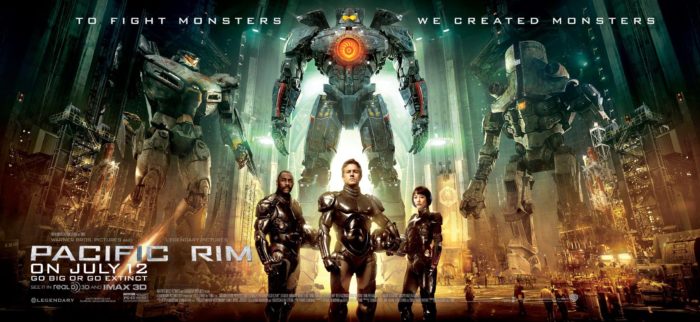Five Reasons to Enjoy ‘Pacific Rim’
“So, I’ve heard a rumor.” A dad from my church edged up to me a couple of weeks ago, his brow furrowed. “I was hoping you could clear it up for me.”
I smiled uneasily. “What is it?”
He leaned closer, his tone low with suspicion. “I have heard … that you like Pacific Rim.”
Gasp.
Yes. I admit it. I love Pacific Rim! Guilty as charged, and unabashedly so.
Maybe you’re wondering, “What is this movie?”
Pacific Rim is a 2013 science-fiction film in which alien monsters (Kaiju) invade Earth, and humanity builds giant mecha robots (Jaegers) to fight against them. If you love action flicks about crazy-huge robots and/or crazy-huge monsters, that’s pretty much all the argument you need to see this movie immediately.
But maybe you need a bit more convincing. Like my bewildered brother-in-Christ, you might be wondering, “Why would anybody like that movie? I don’t get it.” The premise isn’t logical. It seems campy. And the trailer made it look a Transformers copycat.
I can’t contest any of that. But suspend your disbelief for a moment, because I can tell you five reasons to enjoy it despite those things—and why it’s worth giving a shot.

1. An original story-world brimming with fascinating details
Many have grown tired of the continual remakes and big franchises. Pacific Rim is an original film, not based on an existing comic, book, or previous movie. And it is a visual feast. Guillermo del Toro and the filmmaking team put immense care and attention into creating this story-world, crafting each Kaiju uniquely and giving every character a story that goes far deeper than the film shows. Everything is colorful and done with distinct purpose. If you like fresh story-worlds, new ideas, and depth of detail, Pacific Rim may unexpectedly delight you. Every time I watch it, I find more details and nuances to appreciate.
2. Interpersonal dynamics and character development
This movie seems to be advertised as a shallow “monsters versus robots” adventure—and it does deliver a number of fantastic action sequences. But the heart of this film is really its characters and their interpersonal dynamics. This flows naturally out of the fact that each Jaeger is controlled by two pilots in tandem, whose minds and memories are linked through a process called “the Drift.” To be a piloting team, you must be Drift compatible. (Those who have read Kathy Tyers’ Firebird series may find this similar to her concept of “connatural” connections.)
With such a deep interpersonal bond at the very center, it’s no wonder that the characters and their relationships are kept in focus. And the filmmakers’ attention to detail extends to them too; each one stands out from the screen with their own personalities, quirks, disputes, traumas, needs, and ambitions. Even the most odious side character is displayed as a well-rounded person with emotions, flaws, and strengths, and we come to sympathize for him by the story’s end. Parts of the dialogue may sound cheesy to some, but its characters are sincere and believable human beings.
3. Refreshing themes of honor and respect
In today’s culture, many movies exalt rebellion and the subversion of authority. (For example, see how the recent Narnia films tear down all of the noble, virtuous hierarchy C. S. Lewis infused through his work, replacing it with tones of jealousy and glorified disobedience.)
By contrast, I’m forever surprised at how much the theme of respect is woven through Pacific Rim. The protagonist, Raleigh Beckett, has a rebellious streak, but rather than glorifying this trait, the film continually contradicts it, and the answer is never found in defying orders. Perhaps the most striking example of this theme is an exchange between Raleigh and the leading female character, Mako Mori, when Raleigh suggests that they defy their commanding officer (who is also Mako’s mentor):
Raleigh: “We don’t have to just obey him!”
Mako (with soft firmness): “It’s not obedience, Mr Beckett. It’s respect.”
In another moment that may feel old fashioned to modern viewers, Raleigh takes action to defend Mako’s honor when a minor antagonist speaks about her disrespectfully, a moment which I find wonderfully refreshing.
4. A well-written woman (and subtle romance)
Unlike many female characters in action films, Mako Mori isn’t just window dressing or a plot device. Fans have found her so well-written that she inspired the creation of a new media test (similar to the Bechdel test): the Mako Mori test.
Despite being involved in a romantic subplot, her story doesn’t revolve around finding a man. Rather, she is a fully fleshed-out character with a backstory, goals, and a growth arc equal to the protagonist’s (if not, arguably, even more compelling than his). Mako is an unexpected action hero who is quiet and demure—and yet behind that seriousness she is talented, confident, and driven. She fights for what she wants, and she earns it.
Not only that, but the film doesn’t sexualize her, either. In fact, the closest Pacific Rim comes to sexual content is a moment when Raleigh is shirtless in public and Mako peeks at him through a keyhole, noting the scars on his back.
5. Inspiring heroism
Heroism, unity, and self-sacrifice are common themes of speculative fiction films, but they bear mentioning anyway. One of the things I appreciate about this film is the multicultural aspect of the whole world coming together to defend Earth against the Kaiju—ordinary people from many different countries pitted against forces far more powerful. When the world is ending, Raleigh, Mako, and and the other Jaeger pilots don’t question what must be done, but put their lives on the line and face likely death with courage and determination. Like the best sci-fi heroes, they inspire us to put our differences aside, work in unity, and be willing to sacrifice to save others.
Will Pacific Rim: Uprising, which releases March 23 in the U.S., live up to the original film? It will almost certainly deliver on the action-packed monsters vs. aliens element. But will it deliver the same detailed world, character-focused drama, and selfless heroism? That remains to be seen. I shall go to the theater optimistic! But whether Uprising stands or falls, Pacific Rim will always remain one of my favorite movies—for the epic battle sequences, but also for so much more.
And if you’ve never seen it, now is the time!







































Yes, I assumed this movie would be a shallow “monsters versus robots” film. Thanks for the ‘five reasons’. I will definitely make the time to watch Pacific Rim.
Hooray! I hope you enjoy it! 🙂
I have 3 reasons, really:
1) big, fun, dumb boom movie
2) despite dumb booms, not completely trash at characterization
3) see how far my Japanese has advanced (which is, not really)
Hehe, all true! It’s not a serious sci-fi flick; it’s created by a total fanboy. It’s for fun, not for deep philosophical or scientific musings!
This is the first time I’ve heard the term “window dressing.” Haha. Love it.
Good post!
Thank you! 🙂
Well…my reaction to the trailers of this movie was that it was big and dumb. Why would anyone make giant robots to fight giant monsters? It actually makes no sense–why not just build larger numbers of smaller weapons, including lots of penetrating explosive systems (the applied use of explosives can do more than enough damage to take out massive monsters, trust me).
And if you built giant robots, why make them in the shape of humans? Giant robots shaped like centipedes or with tank tracks would have an easier time moving around.
So my hard-science-fiction-loving-guy is talking here. I think physics matters and machines should make sense. But I do suspend that sort of disbelief for Star Wars and maybe I can also do so for Pacific Rim. Your five points give me a reason to give it a try at least.
Though I have to say this is not really an original story. It’s a blend of various Japanese story ideas, including Mobile Suit Gundam and Godzilla. At best, it’s semi-original…but your other four reasons are enough for me to give this movie a try. Thanks.
Ah, yes, exactly! Like Star Wars! You truly have to turn off the hard-sci-fi side of your brain if you’re going to enjoy this movie. The whole premise is kind of silly. It’s made for fun, not for science. 😀
And yes, it is inspired by many Japanese tropes. I think it still qualifies as an original story, though, in the sense that it’s not taken from a book or comic. It’s not based on a preexisting story-world like most popular sci-fi and fantasy movies are (the MCU, the DCEU, Lord of the Rings, Narnia, the new Star Trek movies, etc). 🙂
Thanks for your thoughts, Travis!
Honestly, if a person can’t see that the idea of giant robots battling giant monsters, for WHATEVER REASON, is awesome then I’m not sure what’s going to sell them on this movie. But it may help to know that the movie at least makes an effort to give you some good reasons for why the giant robots have to battle the giant monsters, and that it is totally self-aware about the ridiculousness of its own premise and rolls with it in the most stylish and entertaining way it can.
Of course you can pick apart the science, because it isn’t even pretending to be Proper Science Fiction any more than Star Wars or Doctor Who is pretending to be Proper Science Fiction. It’s taking the trappings and tropes of SF and weaving a wild adventure out of them, and I am 100% okay with that as long as that tone is established in the beginning and maintained through to the end… which it is, in the original PR at least. (I haven’t seen the sequel.)
However, if you’re the sort of viewer who likes to nitpick everything that doesn’t look like Proper Science, and thinks the whole idea of giant robots battling giant monsters is dumb, I’d say it’s fairly certain this movie is not for you.
One of my family’s all time favorite movies!
Lots of fun. Lots of heart. Good stuff.